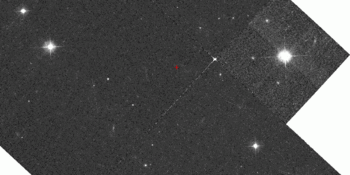3C 66A
| 3C 66A | |
|---|---|
|
Hubble Legacy Archive WFPC2 image of 3C 66A (brightest object on the far right) | |
| Observation data (Epoch J2000) | |
| Constellation | Andromeda |
| Right ascension | 02h 22m 39.612s[1] |
| Declination | +43° 02′ 07.80″[1] |
| Redshift | 0.444[1][2] |
| Distance |
4.5 billion light-years (Light travel time)[2] 5.4 billion light-years (present)[2] |
| Type | BLLAC[2] |
| Apparent magnitude (V) | 15.5[1][2] |
| Other designations | |
| 2E 558, 2EG J0220+4228, B3 0219+428A, QSO B0219+4248[1] | |
| See also: Quasar, List of quasars | |
3C 66A is a blazar[1][2] located in the constellation Andromeda.
The "distance" of a far away galaxy depends on what distance measurement you use. With a redshift of 0.444,[1][2] light from this active galaxy is estimated to have taken around 4.5 billion years to reach us.[2] But as a result of the expansion of the Universe, the present (co-moving) distance to this galaxy is about 5.4 billion light-years (1647 Mpc).[2] Even at this great distance this blazar has an apparent magnitude of about 15.5.[1] Although 0.444 is used as the common redshift value, 0.3347 is a new strict lower limit "inferred through observing the far-UV absorption by the low-z IGM."[3]
3C 66A underwent an optical outburst in 2007 August, as monitored by the Tuorla blazar monitoring program.[4] The event was monitored by the Whole Earth Blazar Telescope project.
References
- 1 2 3 4 5 6 7 8 "3C 66A". SIMBAD Astronomical Database. Retrieved 2010-04-01.
- 1 2 3 4 5 6 7 8 9 "NASA/IPAC Extragalactic Database". Results for 3C 066A. Retrieved 2010-04-01.
- ↑ Furniss, Amy (May 10, 2013). "THE FIRM REDSHIFT LOWER LIMIT OF THE MOST DISTANT TeV-DETECTED BLAZAR PKS 1424+240". Astrophysical Journal Letters. 768 (2): 1. arXiv:1304.4859
 . Bibcode:2013ApJ...768L..31F. doi:10.1088/2041-8205/768/2/L31. Retrieved 7 July 2015.
. Bibcode:2013ApJ...768L..31F. doi:10.1088/2041-8205/768/2/L31. Retrieved 7 July 2015. - ↑ Errando, Manel; Lindfors, Elina; Mazin, Daniel; Prandini, Elisa; Tavecchio, Fabrizio. "A TeV source in the 3C 66A/B region". arXiv:0907.0994
 .
.
External links
- Wikisky image of 3C 66A with 3C 66B (PGC 9067) near the lower left
- The galaxy 3C 66B with 3C 66A in the North-West

